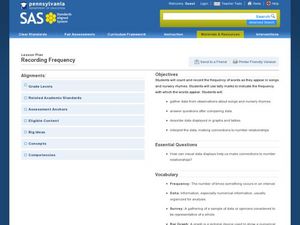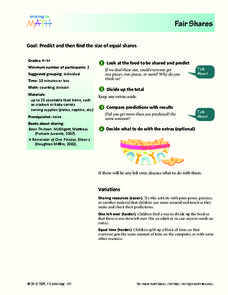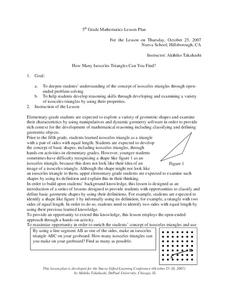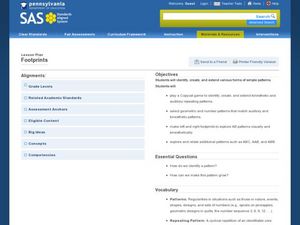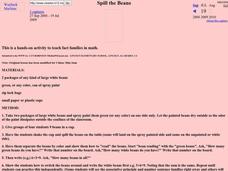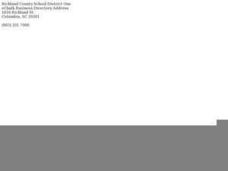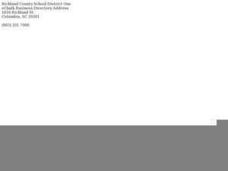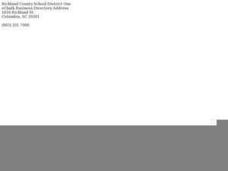Curated OER
Recording Frequency
First graders analyze nursery rhymes and gather data about word frequency. In this frequency lesson, 1st graders create graphs and tables. Students interpret the data.
Curated OER
Fair Shares
Learners investigate division by sharing food items with their classmates. In this division lesson, students are given a food item which they must equally share among the class using division. Learners predict how many portions people...
Curated OER
Cutouts
Students identify symmetry in shapes. For this geometry lesson, students fold paper to identify lines of symmetry. Students create various symmetrical shapes using folded paper.
Curated OER
How many isosceles Triangles Can You Find?
Fifth graders solve problems while examining a variety of isosceles triangles. In this isosceles triangle lesson, 5th graders examine shapes to find their characteristics. Students pay particular attention to the characteristics of...
Curated OER
Footprints
Students explore patterns. In this patterns geometry lesson, students identify and extend patterns including body parts, movement, geometric shapes, noises, and footprints. Students create and share an original pattern.
Curated OER
My Money
Learners identify and interpret the relationships between various components of currency, discusses the uses of money, and provides advanced lessons on making change. They also identify the various ways that money is used and how to use...
Curated OER
Make a Match
Second graders examine the relationship between addition and subtraction. In this number sense instructional activity, 2nd graders practice their computation skills and use various strategies (including manipulatives and calculators) to...
Curated OER
Solving Problems
Second graders become familiar with need strategies for computation of money problems and estimating sums. In this computation lesson, 2nd graders solve real life problems to understand estimation and money problems.
Curated OER
How using number patterns help us add or subtract
Second graders use a number line to understand multiples. In this number line lesson, 2nd graders use a floor size number line and calculate problems with multiples. Students complete a worksheet with multiples.
Curated OER
Circle Circus
Third graders find the radius and diameter of a bubble. In this radius and diameter lesson, 3rd graders create bubbles on their desk and find the radius and diameter of the bubble. Students work in partners to define circle terms and...
Curated OER
The Power of PV: Measuring the Power and Energy of Photovoltaic System
Students explore photovoltaic systems. In this alternative energy lesson plan, students calculate solar panel efficiency and convert devices to solar energy using photovoltaic cells.
Curated OER
Wiggle Worms
First graders investigate worms, collect and analyze data. In this worm and data lesson, 1st graders listen to Chick and Duckling from the Macmillan/McGraw-Hill reading series. They conduct experiments with worms, collect simple data,...
Curated OER
Can You Measure Up?
Learners use technology to visit websites where they play interactive games, gather information to complete activity sheets, and complete online projects. One lesson using 'Inch By Inch' by Leo Lionni, takes students to an interactive...
Curated OER
We Care About Fire Safety
Students investigate the hazards of fires and how to best protect themselves and their family. In this home safety lesson, students examine the importance of a smoke detector and discover how many homes are missing them among their...
Curated OER
Veggie Chop and Data Analysis
First graders chop vegetables into fractions. In this fractions lesson, 1st graders cut vegetables, collect data about favorite vegetables and create a bar graph using the information. Students make inferences about the data and record...
Curated OER
Spill the Beans
Learners explore the meaning of a fact family. In this Math lesson, students work in small groups to create their own fact family based on color of beans. The beans are colored and represent a given value. Learners discover the meaning...
Curated OER
Where are you Spider?
First graders investigate the proximity of objects in space. In this proximity lesson, 1st graders place a felt spider in different locations on a teacher made book, and they describe its proximity to certain items in that book. Students...
Curated OER
Write Me Two Ways
Fifth graders write numbers in standard and expanded form. For this writing numbers in standard and expanded form lesson, 5th graders write integers up to billions in word form and standard form. Students use number cards to create...
Curated OER
What Would Make Our School More "Green"?
Students survey their school to get ideas for how to make the school more environmentally friendly. In this environmental lesson plan, students collect data from other students and teachers. They use the data to create graphs and present...
Curated OER
Flight Dreams - Flight Factors
Students investigate the physics of flight by experimenting in class. In this history of flight instructional activity, students define terms such as gravity, lift, and drag in order to better understand how a plane is able to stay in...
Curated OER
"Money In My Pocket"
Second graders assess a brief history of money, the use of money, working with money as well as adding and subtracting with money and how to spend money wisely with responsibility. In addition, they discuss how everything belongs to God...
Curated OER
Put the Elephant First
Students recreate the order of animals they read about in a book. For this relative positions lesson, students color and cut out pictures of animals in the book. Sudents glue these onto construction paper and line up like the animals in...
Curated OER
The Human Graph
Students produce a graph of favorite colors. In this graphing lesson plan, students create a human graph based on their favorite color then the teacher transfers the data to a bar graph. Students compare the lines on the graph before...
Curated OER
When is Your Birthday?
Students use data about their birthdays to create graphs. In this collecting and communicating information lesson, students make a class list of their birthdays. Students use the information to make a bar graph showing the information.


